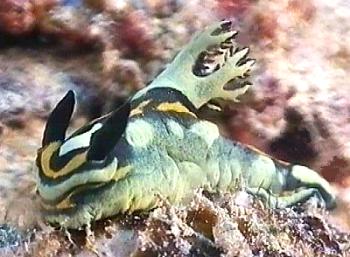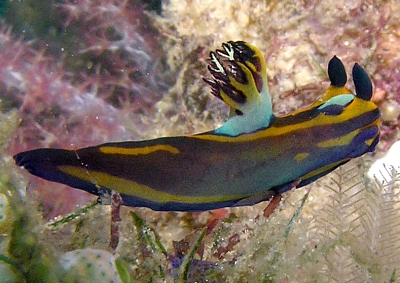
Tambja sp. 4
Order: NUDIBRANCHIA
Suborder: DORIDINA
Superfamily: ANADORIDOIDEA
Family: Polyceridae
Subfamily: Nembrothinae
PHOTO
Near Honiara, Solomon Ids. Photo: Bruce Potter.
See Bruce Potter's message below.
Authorship detailsRudman, W.B., 2000 (September 25) Tambja sp. 4 [In] Sea Slug Forum. Australian Museum, Sydney. Available from http://www.seaslugforum.net/find/tambsp4
Related messages
Re: Tambja olivaria from Bali, Indonesia
October 13, 2008
From: Barbara Hanchard
Concerning message #21949:
Bill,
Sorry I didn't spot the entries under Tambja sp.4. What we can establish by putting the Solomon Islands sightings (Crowley, Potter & Johnson) together, is a record of Tambja sp. 4, poss T. olivaria, on several islands in the Solomons. Potter & Johnson's on Guadacanal, Crowley's in the Western Province and the ones I sent in from the Russell Islands. I also found one in the Florida Islands a few weeks before but didn't manage to get a decent photo. Assumption of course is that they are all the same species. They certainly all look very similar.
Barbara
barbara.hanchard@ffa.int
Hanchard, N.B., 2008 (Oct 13) Re: Tambja olivaria from Bali, Indonesia. [Message in] Sea Slug Forum. Australian Museum, Sydney. Available from http://www.seaslugforum.net/find/21958Thanks Barbara,
Every little bit of information helps
Best wishes,
Bill Rudman
Re: Tambja olivaria from Bali, Indonesia
October 9, 2008
From: Barbara Hanchard

Concerning message #20339:
Dear Bill,
A record of a Solomon Islands Tambja olivaria.
Locality: Bat Cave, Russell Islands, 15 metres, Solomon Islands, Pacific Ocean, 27 September 2008, Reef wall. Length: 40 mm. Photographer: N.Barbara Hanchard.
Regards
Barbara Hanchard
barbara.hanchard@ffa.int


Dear Barbara,
This is an interesting find. It is a puzzling colour form which I have been callingTambja sp. 4 on the Forum. It does not fit any named species very well. A number of records are from the Solomons. It is closest in colour to T. olivaria, but differences, such as the colour of the outside of the gills, suggested to me that it was different. However I suspect your specimen is a link between Tambja sp. 4 and T. olivaria. A few more photos and I suspect I will be accepting Tambja sp. 4 as colour forms of T. olivaria
Best wishes,
Bill Rudman
Tambja sp. 4 ? from the Philippines
April 5, 2006
From: Franca Wermuth

Hello Bill
I think this is an example of Tambja sp.4 from the Tambja affinis colour group, could that be? I found that beautiful nudibranch in about 40m under a black coral.
Locality: Romblon Island, 40m, Romblon Province, Philippines, South China sea, January 2006, under a black coral. Length: 5cm. Photographer: Franca Wermuth.
Franca
fmwermut@active.ch
Wermuth, F., 2006 (Apr 5) Tambja sp. 4 ? from the Philippines. [Message in] Sea Slug Forum. Australian Museum, Sydney. Available from http://www.seaslugforum.net/find/16491
Dear Franca,
Thanks for this interesting find. I don't think we have all the Tambja affinis group sorted out as yet. If the background colour of your animal was green I would have had no hesitation in saying it was Tambja olivaria. Certainly the gill colour and arrangement of the yellow pattern identical. It also looks like Tambja sp. 4 - which could possibly be a colour form of T. olivaria. At present, specimens of Tambja sp. 4 have only been recorded from the Solomon Ids and Papua New Guinea so your animal from the Philippines could be another link between Tambja sp. 4 and T. olivaria. I'll put it on the Tambja sp. 4 - but not with much conviction.
Best wishes,
Bill Rudman
Tambja olivaria from Solomon Ids
January 27, 2005
From: Christopher J. Crowley

Note added 16 August 2005: This species is now re-identified as Tambja sp. 4.
Can anyone please help with the identification of this nudibranch?
It is possibly a Tambja or Roboastra species, but I cannot find it in the Species List here, or in the reference books.
Locality: Morovo Lagoon, Kokoana Pass; Porepore Island, Solomon Islands, South Pacific
Depth: 60 feet. Length: 6 cm. November 2, 2004. on wall. Photographer: Chris Crowley
Thanks,
Chris Crowley
Chris.Crowley@Valley.Net


Dear Chris,
I am pretty sure this is another colour form of Tambja olivaria. This is a recently described species so we are still learning about its geographoc distribution and colour variation. Photos such as yours are useful in building up a better picture on the species.
Best wishes,
Bill Rudman
Tambja sp. 4 from Solomon Ids
December 16, 2002
From: Bruce Potter


Bill,
On a recent dive I found this critter that looks like what you have listed as Tambja sp4. Unfortunately it was slightly damaged, looking like a bite had been taken on one side, including part of the gills. It was at about 16 meters, crawling across a sandy patch in a strong current, so it was difficult to photograph. It was about 30mm long.
This was at a dive site on the outskirts of Honiara, Solomon Islands.
Regards
Bruce Potter
bruce.potter@adventist.org.sb
Potter, B., 2002 (Dec 16) Tambja sp. 4 from Solomon Ids. [Message in] Sea Slug Forum. Australian Museum, Sydney. Available from http://www.seaslugforum.net/find/8520Thanks Bruce,
This seems to be a bit more brightly coloured than earlier examples but clearly the same species
Best wishes,
Bill Rudman
Tambja sp. 4 - colour variation
January 17, 2002
From: Mary Jane Adams

Hi Bill,
When I was in Kavieng, Papua New Guinea, in October, 2001, I dived the "Old Slipway" to see if I could find Tambja sp. 4. This divesite is a muck divers paradise, richly endowed with many species of nudibranchs and other interesting sand dwellers. I found numerous Tambja sp. 4 and a couple of Tambja morosa. The Tambja sp. 4 varied greatly in color pattern from light to dark green with yellow to gold spots and
streaks. I found several of them crawling over the sand slope and many of them concentrated on a white filamentous material, apparently feeding. I dived this site in late afternoon dive and again about 9
pm. I saw more of them on the filamentous stuff at night than in the afternoon. I have dived around Kavieng many times in the past nine years, but this was the first time I have dived at the "Old Slipway" and the first time I have ever seen Tambja sp. 4. The animal in the bottom right photo seems to have lost its gills
Best regards,
Mary Jane
divepng@yahoo.com


Dear Mary Jane,
Thanks for this collection of photos. The white filamentous stuff does appear to be a bryozoan colony of some sort.
Best wishes,
Bill Rudman
Tambja sp. 4 additional photos
October 5, 2001
From: Marli Wakeling


Hi Bill,
Here are some additional views of the Tambja from Papua New Guinea that I mentioned in my earlier message.
Marli
scuabamrli@excite.com
Wakeling, M., 2001 (Oct 5) Tambja sp. 4 additional photos. [Message in] Sea Slug Forum. Australian Museum, Sydney. Available from http://www.seaslugforum.net/find/5363Thanks Marli,
Your upper photo is particularly welcome as it is a second photo of it on an arborescent bryozoan. With Scott's photo we can be fairly confident it is a species of Tambja and that it feeds on bryozoans.
Best wishes,
Bill Rudman.
Tambja sp. 4 from the Solomons
September 29, 2001
From: Scott Johnson


Hi Bill,
Seeing Marli Wakeling's recent photo of Tambja sp. 4 reminded me I had seen the same species in the Solomons in March of 1994. Just like the one in Bruce Potter's photo, it was at the Bonegi site near Honiara. This one was right next to the Bonegi wreck at a depth of about 15m. I presume the bryozoan is its food. The animal measured about 40mm.
Scott.
johnson@kmr.ll.mit.edu
Johnson, S., 2001 (Sep 29) Tambja sp. 4 from the Solomons. [Message in] Sea Slug Forum. Australian Museum, Sydney. Available from http://www.seaslugforum.net/find/5325Dear Scott,
Thanks for the photo. The beautiful bryozoan reminded me I have been planning to prepare a 'bryozoan' page since they feature so prominently as nudibranch food.
Cheers,
Bill
Tambja sp. from Papua New Guinea
September 22, 2001
From: Marli Wakeling

Hi Bill,
This is one of many nudibranch species that I will be sending over the next while. I found a number of these colourful critters on a shallow pier dive called "The Slipway" in Kavieng, Papua New Guinea. They were often with Tambja morosa. I can't seem to find it on any website, but seem to recall seeing it in an ID book in Papua New Guinea. It is about 15 cm in length. Can you help me identify it?
Marli Wakeling.
scubamarli@excite.com
Wakeling, M., 2001 (Sep 22) Tambja sp. from Papua New Guinea. [Message in] Sea Slug Forum. Australian Museum, Sydney. Available from http://www.seaslugforum.net/find/5290Dear Marli,
This has similarities to Roboastra luteolineata but it does not have the prominent oral tentacles so obvious in Robostra. I think it a species of Tambja and I am pretty sure it is the one I have called Tambja sp. 4.
If you have some other photos have a look to see if you have one of it on a bryozoan. Or perhaps one that shows the head f rom a different angle. There seems to be no sign of the oral tentacles in this photo.
Best wishes,
Bill Rudman
Tambja? from Solomon Ids
September 28, 2000
From: Bruce Potter

I found this Nudibranch at Bonegi 1 dive site just outside Honiara, Solomon Ids.
It was in about 12 meters on a mixed rubble bottom. I have not been able to find it in any of my books
Do you have any ideas?
Bruce Potter.
bruce.potter@adventist.org.sb
Potter, B, 2000 (Sep 28) Tambja? from Solomon Ids. [Message in] Sea Slug Forum. Australian Museum, Sydney. Available from http://www.seaslugforum.net/find/3076Dear Bruce,
It could be a colour variation of a known species or it could be something new. Keep a watch out for any similarly coloured animals. It would be nice to know how variable this colour form is.
Best wishes,
Bill Rudman.
